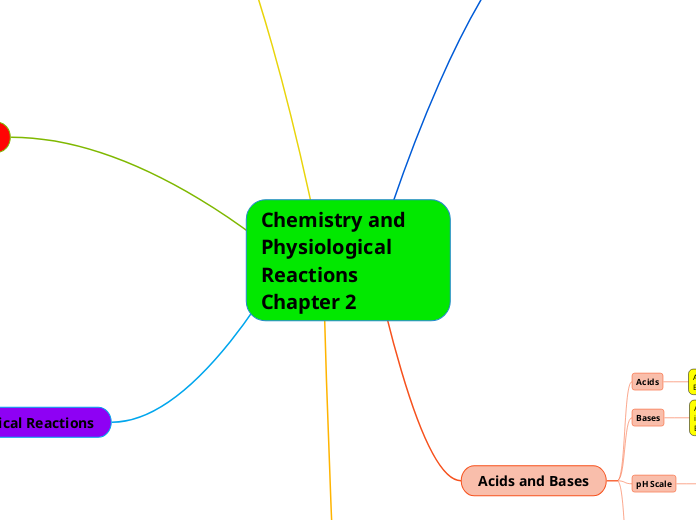by Andrei Alea 1 year ago
282
Chemistry and Physiological Reactions Chapter 2

by Andrei Alea 1 year ago
282

More like this
Organic compounds
Broken down by hydrolysis reaction
Synthesized by dehydration synthesis
Many Polymers are made up of similar units called monomers (building blocks )
Carbs, fats, proteins, and nucleic acids Contain carbon, are usually large, and are covalently bonded
Organic molecules contain carbon
Carbon shares electrons and form four covalent bonds with other elements
Inorganic compounds
Salts Ionic compounds that dissociate into separate ions in water -Separate into cations (positively charged molecules) and anions (negatively charged) -All ions are called electrolytes because they can conduct electrical currents in a solution -Ions play specialized roles in body functions Example: sodium, potassium, calcium, and iron Common salts in the body NaCl, CaCO3, KCl, calcium phosphates
Water Most abundant inorganic compound Accounts for 60%–80% of the volume of living cells
water, salts, and many acids and bases Do not contain carbon
Bonds are both made and broken (also called displacement reactions)
Bonds are broken in larger molecules, resulting in smaller, less complex molecules
Glycogen
Smaller particles are bonded together to form larger, more complex molecules
Amino Acids
Resulting chemical end products
Substances entering into a reaction together
The attractive force between electropositive hydrogen of one molecule and an electronegative atom of another molecule Common between dipoles such as water Also act as intramolecular bonds, holding a large molecule in a three-dimensional shape (eg DNA)
Covalent bonds are formed by sharing of two or more valence shell electrons between two atoms Sharing of 2 electrons results in a single bond Sharing of 4 electrons is a double bond Sharing of 6 electrons is a triple bond → Allows each atom to fill its valence shell at least part of the time
Nonpolar Covalent
Polar Covalent
Ionic bonds involve the transfer of valence shell electrons from one atom to another, resulting in ions One becomes an anion (negative charge) → An atom that gained one or more electrons One becomes a cation (positive charge) → An atom that lost one or more electrons The attraction of opposite charges results in an ionic bond
Two major classes:
Ribonucleic acid (RNA)
Messenger RNA (mRNA), transfer RNA (tRNA), and ribosomal RNA (rRNA)
Contains a ribose sugar (not deoxyribose)
Deoxyribonucleic acid (DNA)
holds the genetic blueprint for the synthesis of all proteins
Shapes of proteins fall into two categories
Globular
Enzymes
globular proteins that act as biological catalysts
Catalysts regulate and increase the speed of chemical reactions without getting used up in the process Lower the energy needed to initiate a chemical reaction → This leads to an increase in the speed of a reaction → Allows for millions of reactions per minute!
antibodies, hormones and enzymes
Contain specific functional regions (active sites)
Tertiary or quaternary structure (3-D)
Compact, spherical, water-soluble, and sensitive to environmental changes
Fibrous
keratin, elastin, collagen and contractile fibers
Provide mechanical support and tensile strength
Most have tertiary or quaternary structure (3-D)
Strand like , water-insoluble, and stable
Many types
Eicosanoids
Steroids
Phospholipids
Triglycerides
3 Classes
Polysaccharides
many sugars
Disaccharides
two sugars
Monosaccharides
Monomers: the smallest unit of carbohydrate
one single sugar